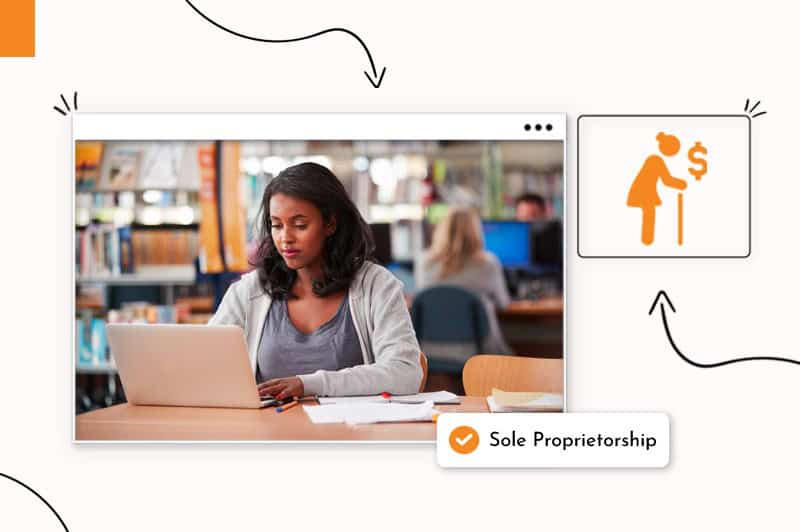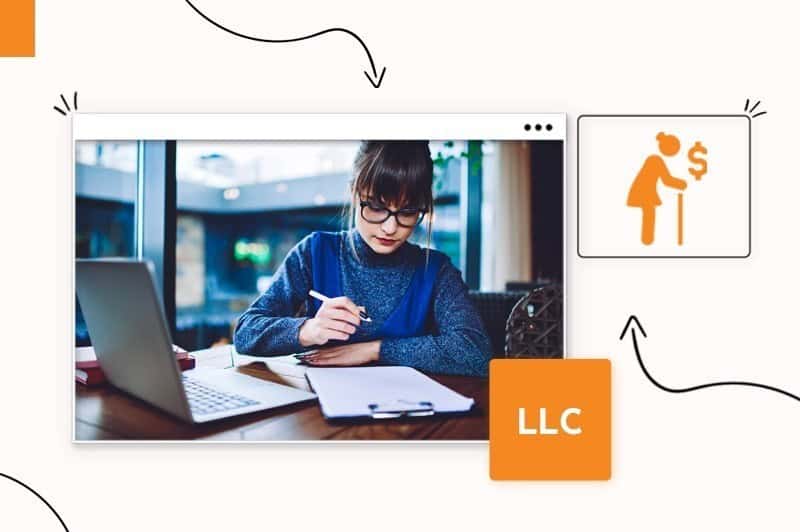
Many small business owners need every dollar to keep their companies running; never mind those unexpected extras that always hit the moment we have a few extra bucks.
The result is we focus on the present rather than the future. But here’s the thing: the future quickly becomes our present, and what we do today shapes our tomorrow!
With that in mind, let’s talk about self-employed retirement plans. This information is relevant for anyone starting or managing a small business. If you’re one of these people, read on!
We have 6 main choices: an IRA (traditional or Roth), a Solo 401 (k), a SEP IRA, a SIMPLE IRA, or a Defined Benefit plan.
Your choice depends on several key factors.
You choose the right self-employed retirement plan by knowing the eligibility requirements, tax benefits, risks, and opportunities.
And we’ll look at those next to help you find the best self-employed retirement plan.
No business success is inevitable, but retirement is.
And if you’re like me, you believe you’ll make your fortune from your business or sell it to fund your pension.
But what happens if we don’t?
Fortunately, if you choose the right self-employed retirement plan, your financial security doesn’t rely on a future million-dollar sale.
Consider Harry Emerson Fosdick’s quote, “Don’t simply retire from something; have something to retire to.”
That’s what a retirement plan does; it provides a financial cushion that can reduce your tax burden and enable you to enjoy your downtime.
And the sooner we save, the more comfortable we’ll be!
Now is when many of us ask, “How do I choose the right retirement plan?
We start by identifying 2 things: What you can afford and which plan provides the best tax deductions. After that, we consider your business type, whether you’ll have employees, and how many.
Retirement plans come on a sliding scale relative to what you earn and invest, and they begin with:
Individual Retirement Accounts, Traditional and Roth, suit business owners earning less than $153,000 in 2023, or $228,000 for married couples working and filing returns together.
The difference between the 2 is with a Traditional IRA, you use pre-tax money for contributions, and after-tax with a Roth IRA.
How to establish a Traditional or Roth IRA:
Determine your eligibility: The contribution limit is $6,500 on an income below $138,000 (single) or $218,000 (married).
Choose how you’ll invest: Use a do-it-yourself (using an online brokerage) or a manage-for-me (using a Robo advisor).
Decide how much you’ll invest: Consider your budget, investment time, and retirement goals, and invest accordingly.
Pick your investments: Contributions are your first step, but you must invest them wisely to build wealth. Robo-advisors do it for you, while do-it-yourself investors choose their asset allocation.
A SEP (Simplified Employee Pension) plan enables business owners to contribute toward their and their employees (optional) retirement savings using an Individual Retirement Account (IRA).
It has similar tax benefits and flexibility to a Traditional IRA, and contributions are on a pre-tax dollars basis with tax-free withdrawals in retirement.
How to establish a SEP IRA:
You can use an online broker to open a SEP IRA account, similar to a Roth or traditional IRA, with additional IRS steps and paperwork.
The IRS steps to start a SEP IRA:
Create a formal written agreement: Use IRS form 5305-SEP or your Robo-account-provider to include eligible employee benefits.
Share certain SEP IRA information with employees: Provide copies of your IRS form 5305-SEP with eligible employees.
Set up SEP IRA accounts: Each employee needs a separate SEP IRA account.
A SIMPLE IRA Plan is for small business owners with 100 or fewer employees who want to contribute to their and their staff’s retirement savings.
Contribution levels are less than a SEP IRA but more than a Traditional IRA and are mandatory for employers using this plan.
SIMPLE IRA plans have fewer start-up and operating costs than other retirement plan options.
How to establish a SIMPLE IRA:
The process to open a SIMPLE IRA is like opening a SEP IRA, with some additional paperwork.
The IRS steps to start a SIMPLE IRA:
Create a formal written agreement: Use IRS form 5304-SIMPLE (not for use with a designated financial institution) or IRS form 5305-SIMPLE (for use with a designated financial institution) outlining employee benefits.
Share certain SIMPLE IRA information with employees: Provide copies of the IRS form 5304-SIMPLE or IRS form 5305-SIMPLE to eligible employees.
Set up SIMPLE IRA accounts: Each employee needs a separate SIMPLE IRA account.
Self-employed entrepreneurs with no employees (but you can include your spouse) can open a Solo 401 (k), also called One-participant 401 (k) Plan.
A Solo 401 (K) allows you to maximize your retirement contributions as an employer and an employee, enabling you to save more and access funds without penalties.
You have 2 Solo 401 (K) plans to choose from, a Traditional 401 (K) and a Roth 401 (K) plan, and the difference between them is pre and post-tax payments. Traditional solo 401k contributors avoid up-front tax, instead paying it when making retirement withdrawals. Roth contributors pay tax now, avoiding it down the line.
How to establish a Solo 401 (K):
Solo 401 (K): You can open a solo 401 (k) using an online broker following these steps:
EIN: Provide your Employer Identification Number.
Paperwork: Complete your broker’s plan adoption agreement and account application form.
Payments: Set up your contributions.
IRS forms: File the annual IRS Form 5500-EZ if you have $250,000 or more in assets; one-participant plan holders with fewer assets may be exempt from filing requirements.
A defined benefit plan is a pension that promises an employee a specified monthly amount in retirement.
Large corporations and self-employed small business owners (like sole proprietors) can use them to make substantial contributions and combine them with other 401 (K) plans to maximize their retirement funds.
Benefit plans are expensive to start, come with high annual fees, need a committed yearly financial fund, and if you have employees, you’ll pay their contributions.
But you can save a lot of cash and defer taxes until retirement.
How to establish a defined benefit plan:
Adopt the plan: You can adopt a pre-approved plan issued by a financial institution or design an individual plan and create an administrator draft outlining the benefit plan details, including contributions and interest rates.
Establish a plan account: Small business owners can open a sole proprietorship-defined benefit plan account that accommodates partners or spouses.
Set your numbers: Determine your contributions by considering age, compensation, IRS regulations, and actuarial assumptions. Your defined benefit plan actuary can assist and consult your certified public accountant or third-party administrator.
Fund your plan: Begin making your contributions before tax filing deadlines.
Employ TPA: Managing a defined benefit plan is serious work and needs someone with experience; here’s where a third-party administrator is essential.

Your choice depends on your situation, so ask yourself the following questions:
Your answers should clarify which of the above self-employment pension plans is best for you, but if you’re still unsure, let’s look at them as a business owner:

A Defined benefit plan is an excellent choice for sole proprietors with a high income as it allows for substantial contributions and deferred taxation. And you can combine a defined pension plan with other plans, like a 401 (K), to increase your retirement contributions and maximize your tax savings.
But suppose a defined pension plan doesn’t suit your needs. In that case, a Solo 401 (k) plan is another excellent choice for sole proprietors and couples working together, with tax-deductible high annual contributions ($66.000 per year) and penalty-free fund access.

The answer could be a SEP or a SIMPLE IRA, depending on your LLC type and your number of employees.
For instance:
SEP-IRA plans might suit a high-earning single-member LLC owner employing fewer than 10 employees because it maximizes their contributions ($66,000 per year) while lowering it (10%) to their employee compensation.
In contrast, SIMPLE-IRA Plans are easier to set up and run, allow for lower savings than a SEP-IRS ($15,500 per year), and suit LLCs with fewer than 100 employees.
Contributions are tax-deductible; LLC owners contribute to their employee’s plans by either matching them at 3% or paying a fixed 2%, and non-exclusive so owners can contribute to another retirement account and maximize their savings.
Not sure whether or not you need an LLC? Read our guide about starting an LLC to learn more.
A corporation’s primary goal (or any business) is to maximize profits, and its workforce is often crucial to achieving it.
One way to attract and keep the highest-quality workforce is by offering benefits, such as retirement plans, and those come in 2 forms:
Qualified retirement plans:
QRPs follow strict Employment Retirement Income Security Act (ERISA) and the Internal Revenue Code (IRC) guidelines regarding plan participation, such as funding, ownership, disclosure, nondiscrimination, and fiduciary matters.
Qualified Retirement Plans provide attractive tax advantages for employers and employees.
For example, employers can deduct contributions from their federal income tax returns. Participants get pre-tax or post-tax contributions, tax deferrals, and, sometimes, tax-free growth.
Examples of qualified retirement plans include:
Nonqualified retirement plans:
As the “non in the name” suggests, NRPs aren’t qualified and do not comply with Employment Retirement Income Security Act guidelines. Resulting in greater flexibility for participants and lower setup and maintenance costs.
Businesses often use Nonqualified Retirement Plans to give high-paid employees additional retirement savings options, and there are 4 primary types:
However, NRPs have disadvantages:
For these reasons, QRPs are often the healthier option. Speaking of which, let’s finish with your physical and financial health.
Health insurance premiums aren’t self-employed retirement plans, but they’re eligible for tax deductions, and some policies also provide retirement benefits when you’re enrolled in a high-deductible retirement plan and using a Health Savings Account (HSA).
Your contributions are tax-deductible/deferred, and any qualified medical expense withdrawals up to 65 years of age are tax free. After 65, any cash you withdraw from your HSA (for whatever reason) pays tax at the standard income tax rate.
The takeaway:
A HSA is another way to increase your retirement savings, claim tax deductions, and defer tax payments to a more favorable time.
You pay your self-employed retirement payments first and yourself 2nd.
The answer depends on your circumstances, such as business type, whether you have employees, age, and income. The trick is to choose a plan that suits your business situation, lifestyle, family, and financial retirement goals.
Choose your self-employed retirement plan, find a broker online, and complete the IRS paperwork.
If you (and your spouse) are your business’ sole employees, the Solo 401 (K) offers high cash-saving options and excellent tax advantages.
Traditional and Roth IRAs suit new business owners on a low income and (when applicable) wanting to roll over their existing 401 (K) into their new IRA.
The difference is you pay pre-tax on your Traditional retirement contributions and post-tax on your Roth.
With similar annual contribution limits of $ 66,000 per year, the solo 401 (k) and SEP IRA seem identical.
However, only the 401 (K) offers a catch-up contribution option for those 50 years or older ($6,500 per year). A 401 (K) is often better for single freelancers as it allows you to choose pre or post-tax payments (depending on your plan) and include your spouse in the contributions.
A ROTH IRA and SEP IRA provide tax benefits in retirement; the difference is that a ROTH IRA provides tax-free growth and retirement withdrawals, and a SEP IRA offers tax-deferred growth.
However, Roth IRAs come with zero penalties for early withdrawals, so they suit people who might need to access funds before retirement.
A Keogh (or HR-10) is a self-employed and small business owners’ retirement savings plan that provides tax advantages, such as tax-deductible contributions and tax-deferred growth.
Conclusion
Most small business owners (like you and me) consider self-employment retirement plans for one of the 3 following reasons.
We want to start a business. We just have. Or we did some time ago and are finally ready to invest in our future.
Whatever your reason, it’s always the right time to invest in your future, and there’s a self-employed retirement plan to suit every type of entrepreneur.
When choosing, consult a chartered public accountant or financial advisor before signing the dotted line.
This portion of our website is for informational or educational purposes only. Tailor Brands is not a law firm, and the information on this website does not constitute legal advice. All statements, opinions, recommendations, and conclusions are solely the expression of the author and provided on an as-is basis. Accordingly, Tailor Brands is not responsible for the information and/or its accuracy or completeness. It also does not indicate any affiliation between Tailor Brands and any other brands, services or logos on this page.
Products
Resources
©2025 Copyright Tailor Brands